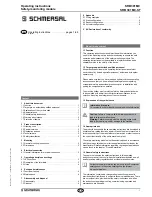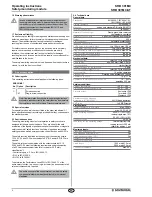
4
Operating instructions
Safety-monitoring module
SRB 301MC
SRB 301MC-ST
EN
5.3 Notes
Signalling outputs must not be used in safety circuits.
Due to the operating principle of the electronic fuse,
the customer must check that no hazard is caused by
an unexpected restart in circuits without reset button
(automatic reset).
Opening the front cover (see Fig. 2)
• To open the front cover, insert a slotted screwdriver in the top and
bottom cover notch and gently lift it.
• When the front cover is open, the electrostatic discharge requirements
must be respected and observed.
• After setting, the front cover must be fitted back in position.
Only touch the components after electrical discharge!
Setting the switch (see Fig. 3)
• The cross-wire short monitoring function (factory setting) is
programmed by means of the switch underneath the front cover of the
safety-monitoring module.
• The switch must only be operated in de-energised condition by means
of a finger or an insulated blunt tool.
• Pos. nQS (top): Not cross-wire short proof,
suitable for 1-channel applications with outputs connected to potential
in the control circuits.
• Pos. QS (bottom), Cross-wire short proof:
suitable for 2-channel applications without outputs connected to
potential in the control circuits.
U
B
U
i
K1
K2
SRB
301
S11 13 23 33
S12 14 24 34
S21 42 X2 A2
S22 41 X1 A1
U
B
U
i
K1
K2
SRB
301
S11 13 23 33
S12 14 24 34
S21 42 X2 A2
S22 41 X1 A1
U
B
U
i
K1
K2
SRB
301
S11 13 23 33
S12 14 24 34
S21 42 X2 A2
S22 41 X1 A1
S12 18 28 38
S22 45 X1 A1
nQS
QS
Fig. 1
Fig. 2
Fig. 3
6. Set-up and maintenance
6.1 Functional testing
The safety function of the safety-monitoring module must be tested.
The following conditions must be previously checked and met:
1. Correct fixing
2. Check the integrity of the cable entry and connections
3. Check the safety-monitoring module's enclosure for damage.
4. Check the electrical function of the connected sensors and their
influence on the safety-monitoring module and the downstream
actuators
6.2 Maintenance
A regular visual inspection and functional test, including the following
steps, is recommended:
1. Check the correct fixing of the safety-monitoring module
2. Check the cable for damages
3. Check electrical function
If a manual functional check is necessary to detect a
possible accumulation of faults, then this must take place
during the intervals noted as follows:
• at least every month for PL e with category 3 or
category 4 (according to ISO 13849-1) or SIL 3 with HFT
(hardware fault tolerance) = 1 (according to IEC 62061);
• at least every 12 months for PL d with category 3
(according to ISO 13849-1) or SIL 2 with HFT
(hardware fault tolerance) = 1 (according to IEC 62061).
Damaged or defective components must be replaced.
7. Disassembly and disposal
7.1 Disassembly
The safety-monitoring module must be disassembled in a de-energised
condition only. Push up the bottom of the enclosure and hang out
slightly tilted forwards.
7.2 Disposal
The safety-monitoring module must be disposed of in an appropriate
manner in accordance with the national prescriptions and legislations.

























